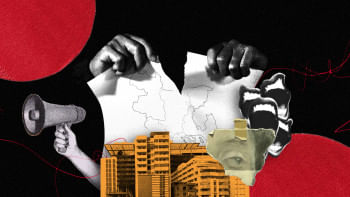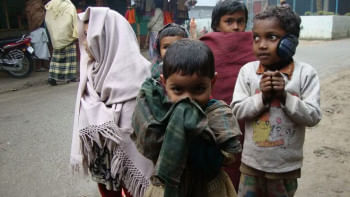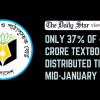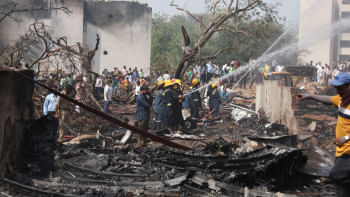The controversy over the NCTB textbook

The lizard is one of 200 species capable of separating its tail from its body. Known as autotomy, this self-amputation is a defence mechanism that lizards use to deflect an attacker's attention. In response to any reflex spasm, the lizard can detach its limb located in the fracture plane.
For us humans, the fracture plane is sociopolitical. Often, we notice many tail-wagging incidents that bring our primal reactions to the fore. The debate over the inclusion of gender identity in a national curriculum textbook for Class VII is a case in point. The severed tail is twitching and turning in all directions, keeping the audience engaged in a discussion on the "third gender" (as stated by the law of the land). The body politic seems to be enjoying the performance of one of its organs from a safe distance.
The hullabaloo entailed a case study on an imaginary boy who preferred to identify as a female. He eventually sought refuge in the community known as the "hijra." The concept of being born in the "wrong" body—that is, transgender—has generated this controversy.
A private university teacher tore out two chapters from a copy of the textbook in public to protest the issue. His performative stunt during a national teachers' convention caught the attention of many who are not willing to make room for the other beyond their traditional shells. The incident led his employer to remove him from his institutional body, but the tail-losing dance drew more people to the university's gate.
The national textbook writers probably did not give it enough thought, which is why the government's admirable objective of giving voice to the marginalised has unexpectedly backfired. This debate revolves around the conflation of intersex and transgender people. The original goal of encouraging tolerance has thus become counterproductive. Questions are also being asked about whether it is appropriate to expose schoolchildren to such complex issues at such an early stage. The National Curriculum and Textbook Board (NCTB) selected Class VII for the case study, thinking adolescence to be a suitable time to address gender identity. There are others who think that these issues should have been addressed at the higher secondary or university levels.
The government has already established a five-person committee to review the content. Three of the members represent religious institutions, while the other two are from the NCTB and Dhaka University's Institute of Education and Research, respectively. The intricacy of the subject, however, demanded the presence of at least one sociologist or gender expert.
Let us now shift our focus to the teacher who launched this book-tearing campaign. The irony is that an educator should be the last person to advocate tearing pages out of books. His knee-jerk reaction will send the incorrect message to our students and their parents. Since the issue is one of academia, he should have asked his colleagues in academia to come up with a solution. I can see how the text's ambiguity has given rise to such reactionary responses. Indeed, a textbook's message must be carefully chosen, as it has a lasting impact on a student's intellectual aptitude and social awareness.
But when the dancing tail becomes an incredulous needle in our moral compass, there are reasons to be worried. How can we promote tolerance when we ourselves are intolerant? How can we champion democracy when we do not accept plurality? The level of insensitivity shows a lack of democratic principles all around. Children will not learn inclusivity and tolerance if we adults do not practise such behaviours in our everyday lives.
Our democratic behaviour is characterised by a strange mix of selectivity and opportunism. It beats anybody's imagination when concerns such as price increases, money laundering, inflation, freedom of speech or mass murder in Gaza appear to receive less attention than the desire for an individual's identity change. The interest generated by the case study makes us alert to certain dos and donts.
Given the sensitivity of the topic, the textbook author should have been thoroughly reviewed during its pilot phase. A trial through a robust democracy would have given the material its validity. Regretfully, when some teachers at Dhaka University attempted to organise a debate about these textbooks shortly after their release, the meeting had to be postponed. Before the election, there was immediate concern that this kind of gathering would turn into a forum for bitter criticism of the administration.
The focus on the tree has missed the forest, involving the future of our posterity. The textual content can make or break a generation. Any compromise in text-making and its reception can seriously hamper the intellectual growth of our learners.
Our education must be a site for critical thinking and creative expression. We need to understand what type of education has perpetuated harmful stereotypes and caused misconceptions. The hostility against giving space to the marginalised can be addressed by highlighting the status of the hijra community, while adhering to the national laws and norms regarding hijra. This could also entail thinking about anti-discrimination legislation, freedom of speech, bullying, and how schools influence public opinion and democracy.
It is easy to be distracted by the seductive tail tale, but we need to revert our attention to the main body, i.e. the body politic, a polity involving the state. We need to understand its weakness—the fracture plane where our democracy operates. We need to understand why the severance of limb tolerance is symptomatic of a systemic weakness. Only then will we understand why the tail wags, and what wags the tail.
Dr Shamsad Mortuza is a professor of English at Dhaka University.
Views expressed in this article are the author's own.
Follow The Daily Star Opinion on Facebook for the latest opinions, commentaries and analyses by experts and professionals. To contribute your article or letter to The Daily Star Opinion, see our guidelines for submission.

 For all latest news, follow The Daily Star's Google News channel.
For all latest news, follow The Daily Star's Google News channel. 










Comments